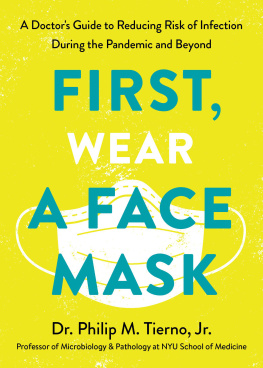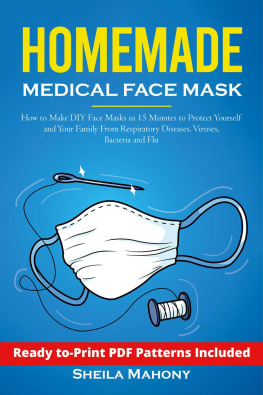Contents
Landmarks
Print Page List
ACKNOWLEDGMENTS
Writing a book during a raging pandemic, the worst of my lifetime, is an experience that is filled with mixed feelings. On one hand I felt some comfort in that I was providing helpful information in the form of protective response strategies for infectious diseases, while on the other hand witnessing the extraordinary incidence of death and suffering caused by the COVID-19 virus was sad and sobering. Nevertheless, the experience proved to me that science prevails because it provides the framework to extricate humanity from the horrors of germ events, but only if we all heed the knowledge gained over the past two millennia. Unfortunately, as the cartoon character Pogo once uttered, We have met the enemy, and he is us.
While writing this book, I have had the benefit of working with a skilled senior editor, Donna Loffredo of Penguin Random House. I thank her for her insightful editing and for enthusiastically guiding the book to completion. I also thank her colleagues for their assistance, especially editorial assistant Katherine Leak.
I am grateful to my wife, Josephine, who had to listen to many iterations of various sections of the book ad nauseam. I thank her for her patience and for being my best sounding board.
ABOUT THE AUTHOR
Dr. Philip M. Tierno, Jr., is a microbiologist with more than forty years of experience in the field of Clinical and Medical Microbiology. He was the Director of Clinical Microbiology and Diagnostic Immunology at Tisch Hospital, New York University Langone Medical Center, and is currently Professor of Microbiology and Pathology at the New York University School of Medicine. Dr. Tierno has been recognized extensively for his numerous contributions to the medical and scientific community, including the honor of Knighthood by the Sovereign Military and Hospitaller Order of St. John of Jerusalem of Rhodes and of Malta for his work on toxic shock syndrome. His work has appeared in publications such as the American Journal of Public Health, Journal of Clinical Microbiology, JAMA, and Journal of Infectious Diseases, and he is the author of several books, including The Secret Life of Germs, Protect Yourself Against Bioterrorism, and Nuclear, Chemical and Biological Terrorism: Emergency Response and Public Protection. He has appeared on both local network and cable television shows, including 20/20, Dr. Oz, Good Morning America, Oprah, The Montel Williams Show, Dateline, Nightline, Today, Primetime, Katie, Cuomo Prime Time, and CNN.
PARTING WORDS
N o one can avoid all risk. Its a part of life. However, you can keep calm and minimize many risks once youre empowered with knowledge. Your health depends on everyones sense of responsibility and concern for one anotherwe are all connected. The flip side of that, though, is pretty inspiring. While you cant save the whole world at once, you can improve the worlds health one person, and one person-to-person interaction, at a time.
In short, the first step to improving the health of the planet is to take care of yourself. That will go a very long way in keeping yourself safe, too. Dont panic, wear a face mask, wash your hands, and youll already be making a difference.
WHATS A CORONAVIRUS?
Y ou probably picked up this book because youre worried about COVID-19, so lets start there.
Coronaviruses are a worldwide group of RNA (ribonucleic acid, the genetic material of some viruses) viruses that were first identified in the 1960s. Bacterial and human cells have both RNA and DNA, but viruses have either one but not both, because they are more primitive cell types. They are the cause of about 15 to 30 percent of common colds, usually in the winter months. The primary symptoms produced are similar to another cold virus, rhinoviruses (which cause about 50 percent of common colds), and both are typified by an upper respiratory infection with a stuffy nose (loss of smell and taste are common), coughing (usually dry), varying fever, malaise, and fatigue.
Some adults carry the virus without fever. And most of these ordinary strains are treated with over-the-counter medications for the symptoms that they cause. The infection rarely spreads to the lower respiratory tract to cause pneumonia. Thats more likely to occur in people who are older, or who have comorbidities like COPD, heart disease, diabetes, or are immunosuppressed.
Studies have shown that antibodies to the coronavirus appear in childhood and increase with age. It has also been shown that people can be reinfected in some cases after a period of about a year (thats why respiratory viruses continually cause colds in humans), although immunity usually lasts longer, and maybe even for life. Coronaviruses are also suspected of causing gastroenteritis, with the virus sometimes found in the stool. Animals also have infections caused by coronaviruses, but their viruses usually do not infect humans and, vice versa, human strains dont usually infect animals.
Sometimes, however, they do. An outbreak of a novel coronavirus that jumped from animals to humans, called SARS (severe acute respiratory syndrome), occurred in South China in late 2002 and, by the time it waned in mid-2003, resulted in 8,000 cases in 29 countries, with more than 800 deaths (a case fatality rate of 10 percent). Clearly, we learned in that outbreak that animal coronaviruses can mutate and jump from animal species to humans. In fact, a perfect evolutionary melting pot occurred in the Chinese open-air animal market where people commingled with animals daily. These animals were slaughtered on the spot and then packaged and sold to people who used them in ritual ceremonies or for food delicacies.
Coronaviruses have the ability to exhibit a high frequency of mutation, and an especially high incidence of deletion mutations. They also undergo a high frequency of recombination during replication. This becomes a perfect prerequisite for a mutation that allows jumping species from animals to humans. It is believed that the SARS virus, for example, jumped from a bat to a civet cat to humans. In 2012 there was another coronavirus outbreak called MERS (Middle East respiratory syndrome). According to the CDC, health officials first reported the disease in Saudi Arabia in September 2012 but later identified that the actual first MERS case occurred in Jordan in April 2012. It then spread from the Middle East to Africa, Asia, and Europe. In May 2015 there was an outbreak of MERS in Korea, which was the largest outbreak recorded at that time. The MERS virus has a reservoir in camels and had the highest mortality rate, 35 percent.
Next comes the new coronavirus disease of 2019 (aka HCoV-19, COVID-19, nCoV-19, SARS-CoV-2). I will use the COVID-19 designation, which really refers to the disease caused by the virus, for convenience. This strain of virus is different from all others in that it causes more severe disease, especially in older adults, than the seasonal flu but less severe than SARS and MERS. This novel coronavirus likewise originated from animals and jumped from animal species to humans. It has been reported that in the open-air animal market in Wuhan, China, it likely spread from a bat (the COVID-19 virus is almost identical to a bat coronavirus), then likely to a pangolin (scaly anteater), and then to humans via a mutation that occurred during replication.
Several researchers have genetically traced the origin of the New York strains of the COVID-19 virus and found that it most resembled European strains. Hence the original virus started in Wuhan, China, traveled to Europe, and then finally a traveler from Europe brought it to New York. The West Coast received the Wuhan strain from passengers traveling from China to L.A. By 2020 it takes the prize of all previous coronavirus infections. It is spread by direct and indirect contact from one person to another via large aerosol droplets of greater than 5 microns (micrometers) in diameter as well as via airborne droplets (smaller droplets) less than 5 microns in size. The virus has also been reported to remain suspended in the air for at least 3 hours. Indirect spread occurs from contaminated surfaces being touched by hands and then those hands touching your nose, mouth, or eyes, which are the conduits of entry into your body. That is why handwashing is the single most important thing you can do to protect yourself!



